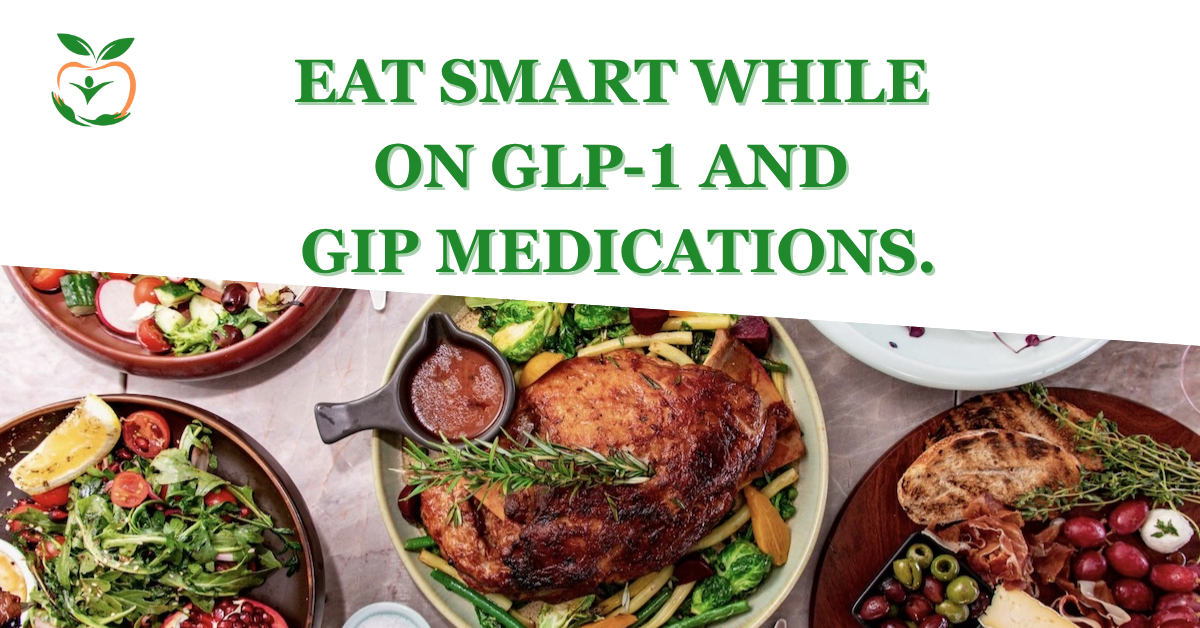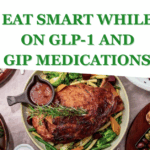
Eating Smart on GLP-1 & GIP Medications: A Guide to Food That Supports Your Weight Loss Journey
Eating Smart on GLP-1 & GIP Medications: A Guide to Food That Supports Your Weight Loss Journey
Starting a medication like semaglutide (Ozempic®, Wegovy®) or tirzepatide (Mounjaro®, Zepbound®) is a big step toward better health. These medicines help you feel fuller, eat less, and improve blood sugar control. But what you eat still matters—a lot. The right foods not only boost your weight loss results but also help keep side effects (like nausea or constipation) under control.
Here’s your guide to eating smart while on GLP-1 and GIP medications.
⸻
1. Protein Is Your Best Friend 





When losing weight, it’s important to protect your muscle while burning fat. Protein keeps you fuller, supports muscle health, and stabilizes blood sugar.
Best protein picks:
•Lean chicken, turkey, or fish
•Eggs or egg whites
•Greek yogurt or cottage cheese
•Tofu, tempeh, or lentils
•Protein shakes (low sugar, whey or plant-based)
 Aim for protein at every meal—think of it as the “anchor” of your plate.
Aim for protein at every meal—think of it as the “anchor” of your plate.⸻
2. Fiber for Fullness & Gut Health 





GLP-1 and GIP medications can slow digestion, which sometimes causes constipation. Fiber helps keep things moving while also keeping you satisfied longer.
Great fiber foods:
•Vegetables: broccoli, spinach, asparagus, zucchini
•Fruits: berries, apples, pears (skin on)
•Whole grains: oats, quinoa, brown rice
•Legumes: black beans, chickpeas, lentils
 Increase fiber slowly and drink water—too much, too fast can cause bloating.
Increase fiber slowly and drink water—too much, too fast can cause bloating.⸻
3. Hydration Matters 

Because these meds slow digestion, staying hydrated helps prevent constipation and nausea.
•Aim for at least 6–8 cups of water daily
•Herbal teas and sparkling water (without added sugar) are good options
•Limit sodas and fruit juices—they add sugar without helping satiety
 Sip water throughout the day instead of gulping large amounts at once.
Sip water throughout the day instead of gulping large amounts at once.⸻
4. Healthy Fats Keep You Satisfied 





Fats aren’t the enemy—they’re essential for hormone health and help you feel satisfied. The trick is choosing the right kinds and keeping portions moderate.
Smart fat choices:
•Avocado
•Olive oil
•Nuts and seeds (almonds, chia, flax)
•Fatty fish (salmon, sardines)
 Pair a little healthy fat with fiber and protein for meals that keep you full longer.
Pair a little healthy fat with fiber and protein for meals that keep you full longer.⸻
5. Foods to Limit 

Some foods can worsen side effects or slow down your progress.
•Greasy, fried foods → can trigger nausea
•Large heavy meals → harder to digest
•Sugary drinks & sweets → spike blood sugar and add empty calories
•Alcohol → may worsen nausea and interfere with weight loss
 Instead of cutting everything out, try portion control and mindful swaps.
Instead of cutting everything out, try portion control and mindful swaps.⸻
6. Portion Control & Mindful Eating 

Your appetite is naturally reduced on these medications. Listen to your body—eat slowly and stop when comfortably full.
•Use smaller plates to avoid overeating
•Put your fork down between bites
•Avoid distractions (like TV) while eating
 What feels like “half a plate” now may actually be the right amount for your body.
What feels like “half a plate” now may actually be the right amount for your body.⸻
7. Sample Day of Eating on GLP-1/GIP
Here’s a balanced day of meals that support weight loss:
•Breakfast: Greek yogurt with berries and chia seeds
•Snack: Handful of almonds + herbal tea
•Lunch: Grilled chicken salad with mixed greens, olive oil, and quinoa
•Snack: Baby carrots + hummus
•Dinner: Baked salmon with steamed broccoli and roasted sweet potato
•Evening option (if hungry): Protein shake or cottage cheese with cinnamon
⸻
The Bottom Line
GLP-1 and GIP medications are powerful tools for weight loss—but food is still your foundation. Focus on protein, fiber, hydration, and balanced meals to get the best results while avoiding side effects. Remember: you don’t need to eat less, you need to eat smart.
⸻
 Next step: Try keeping a food journal for the first month on your medication. Track meals, hydration, and how your body feels. This helps you (and your healthcare team) fine-tune your diet for the best possible results.
Next step: Try keeping a food journal for the first month on your medication. Track meals, hydration, and how your body feels. This helps you (and your healthcare team) fine-tune your diet for the best possible results.

